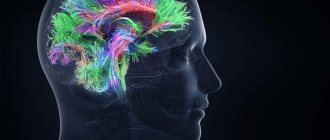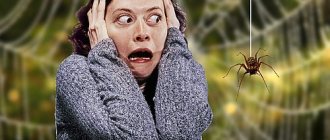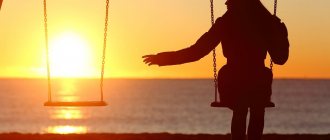The unconscious fear of being in a public place without being able to leave, or of being in a situation in which panic or anxiety may develop, is called agoraphobia. What is this? The answer is: a severe mental illness of the neurotic spectrum, related to anxiety-phobic disorders, the so-called fear of open spaces. To put it simply, along with other phobias, this is also a type of neurosis.
Necessary and not so necessary information
The name “agoraphobia” comes from the merger of the Greek words ἀγορά (agora), which means “market,” and φόβος (phobos), which means “fear.” The term appeared in 1871. Previously, such pathology was considered by specialists as a manifestation of generalized anxiety. This was the case until 1980, when, based on many years of observations, it was concluded that these disorders are caused by different reasons and differ in development and response to therapy.
Fear has been living in us since the appearance of the second, it is as ancient as the very existence of homosapiens. It is based on biology and physiology, so it is very simple to justify. A man, leaving the thicket of a forest into an open space, was afraid to encounter something unknown that could threaten his life, and he had no opportunity to hide. And when global migration and clashes between tribes began, the fear of a crowd appeared, in which anyone could be injured or trampled. All this remains in our genetic memory.
Now it is clear that agoraphobia is two types of fear: panic in a crowded place and discomfort in an open area. Sometimes it is called fear of life: a person suffering from it feels calm only in his own home, he seems to be locking himself in - he cannot go to work, buy groceries, visit a museum or concert. He is not able to be on a subconscious level where everything is “seething”. A patient may experience a panic attack:
- in a market or store full of people;
- on an empty street;
- at public transport stops and inside it;
- at a rally, stadium, parade;
- in the auditorium;
- indoors with open doors and windows, etc.
Even in the hairdresser's chair, such a person can panic! And the point here is not that in some cases there is no open space and a large mass of people, but in accessibility, the lack of opportunity to escape and hide unnoticed.
The prevalence of agoraphobia has made it popular in the creative community: there are, for example, quite a lot of musical works on this topic. Cinema did not stand aside either: the plot of such films as the Russian “Closed Spaces”, the Canadian “Frozen in Fear”, the Belgian “Tom in Love”, the Italian “Best Offer”, the American “Imitator”, etc. is based on it.
Among the famous actors there were and are agoraphobes: Marilyn Monroe, who died early, Macaulay Kalin, Daryl Hannah, Kim Bassinger, as well as the notorious director Woody Allen. This disease has brought and continues to bring a lot of troubles and difficulties to all of them.
Description of the disease
This type of mental disorder was first described back in the 19th century by the German scientist and physician Karl Westphal, although this was not at all easy to do, given the fact that the described illness often acts as an integral component of other pathological manifestations.
It was not by chance that agoraphobia got its name, because in translation from ancient Greek “agora” means “market, bazaar”, and “phobia” means “fear, apprehension”, that is, we are talking about uncontrollable, unconscious horror provoked by large open spaces and/ or a crowd of people.
Main manifestations of the disease
Unfortunately, agoraphobia manifests itself not only in the fear of open spaces; the clinical picture of this mental disorder is often much more complex, accompanied by specific manifestations of varying degrees of severity.
Thus, the symptoms characteristic of agoraphobia are most often of the following nature :
- Discomfort when leaving your own home.
- Staying in public places, not only open, but also closed, including transport, catering, parks, etc.
- Fear of attracting the attention of a crowd or even a limited group of strangers, which often arises in restaurants, hairdressers, hospitals, and shops.
- Anxiety at the mere thought of traveling alone or even just going about your business alone.
- Fear of fear itself, caused by a feeling of extreme anxiety due to the fact that a panic attack may begin at any moment, which will certainly attract the attention of others.
- Fear of being in an unusual environment, which could theoretically cause damage to health (fear of freezing, fear of hunger, fear of being attacked by intruders, and so on).
- An obsessive desire to stay in a comfort zone, which each person suffering from agoraphobia has their own, as well as panic and anxiety when leaving it. For example, some agoraphobes can receive guests only in certain places, while others instinctively select several such zones at once, which allow them to lead a lifestyle quite familiar to an ordinary person (work, place of rest, home).
However, even attempts at adaptation with the subconscious identification of several zones in which a person suffering from a mental disorder feels more or less calm do not make his life complete.
Associated symptoms
The situation is even worse in those patients in whom panic attacks, characteristic of the acute manifestation of agoraphobia, affect physiology.
As a rule, we are talking about the following negative manifestations :
- severe tachycardia;
- excessive sweating;
- trembling in the body and disruptions in the usual breathing rhythm;
- semi-fainting and fainting;
- dizziness, confusion in thoughts, decreased reaction;
- nausea to the point of vomiting;
- uncontrolled urination and reactive diarrhea.
Such a clinic inevitably leads to complete asocialization of the patient, since knowledge of possible consequences provokes severe fear and anxiety in him even before entering the zone of discomfort. It also happens that physiological pathologies begin to manifest themselves directly while expecting something unpleasant, as a result of which the patient strives for complete self-isolation, trying not to leave his hermit shell at all.
Meanwhile, the frequency of panic attacks with agoraphobia is extremely high and, according to statistics, similar symptoms are observed in 8-9 patients out of 10. The course of the disease can be facilitated by the help of loved ones, and many agoraphobes always try to keep with them one or more people in whom they sure.
However, this approach to the problem gives only a temporary result, greatly complicating the life of those who want to help a person suffering from agoraphobia. So the only way to correct the disease is to find the root cause of its manifestation.
Reasons for the development of agoraphobia
Initially, it may seem that agoraphobia is quite easy to confuse with mental disorders such as social phobia, autism, and other pathologies with similar clinical manifestations.
However, this is not the case, and the main difference between the disease in question is that it tends to manifest itself not from childhood, but in a later period - from 20 to 25 years. Very often, patients cannot determine the cause of the development of the disease, noting that its first manifestation occurred in a completely familiar environment (visiting a restaurant, visiting busy places, traveling on public transport). However, the diagnostician will be able to make a final verdict only after a complete clinical picture has been drawn up, provided that the patient exhibits at least two signs of the disease.
As for the causes of the disease, despite the fact that many agoraphobes do not see any special prerequisites for developing a fear of open space, they exist, because such pathologies do not appear out of the blue. These include :
- Negative experiences experienced in childhood associated with communication with peers or representatives of other age groups. Even some shameful situation that happened in front of a large number of people can give impetus to the development of the disease in the future.
- Low self-esteem, a feeling of insecurity in oneself and in the safety of the world around us, excessive suspicion, a constant feeling of one’s own powerlessness in the face of circumstances and the elements.
- Fear of looking funny in the eyes of others, intolerance to criticism, vulnerability and pathological secrecy, which is often observed in people who are afraid of causing general condemnation of their own thoughts and actions.
- Sexual violence, direct or indirect participation in hostilities, experienced natural disasters, man-made disasters, etc.
- Alcohol abuse, drug addiction, use of any other stimulants and VIS, including medications and antidepressants.
- Any disruption of the relationship between the patient’s vestibular apparatus and his perception, which may lead to disorientation in space.
- Hormonal changes.
- Vegetovascular and neurocirculatory dystonia.
More often than others, overly sensitive, receptive and impressionable people who are prone to depression and emotional overexcitement, which can arise even against the background of a normal conversation, are susceptible to illness.
It should be remembered that such people automatically fall into the risk zone, so they need to constantly work on themselves, not allowing their already fragile nervous system to weaken.
Reasons for appearance
Experts cannot name the main “culprit” for the development of agoraphobia. It is believed that the root cause is a panic attack, which turns into an anxiety disorder. Others believe the diametrically opposite: first a fear of open spaces appears, and panic attacks “follow” from it. A compromise between these theories has not yet been achieved, but one thing is clear - these pathologies are very closely related.
Sigmund Freud's concept
The founder of psychoanalysis proposed his concept of the development of agoraphobia and other anxiety disorders: since they are all neurotic pathologies (neuroses), their origin is at the psychogenic level.
Freud believed that the main symptom of the disease, anxiety, is the result of an intrapersonal conflict that arose in childhood or adolescence, a compromise between the drive (“it”) and the prohibition on this desired (“superego”). This, in turn, transforms into sensations such as tremor, shortness of breath, and suffocation.
Academician Pavlov's theory
The great physiologist considered any fear to be a conditioned reflex. That is, if some incident occurs to an individual or a person close to him, causing fear, then when he finds himself in such a situation, the brain begins to “sound the alarm.” Over time, growing like a snowball, such fear transforms into agoraphobia. But one can argue with this: not all people who have experienced trouble in a crowd get sick, and on the contrary, the disorder develops in those who have not had such cases.
Is the vestibular apparatus to blame for everything?
Not so long ago, research results appeared claiming that it is problems with the vestibular apparatus that are responsible for agoraphobia. It is located in the inner ear, in the bony labyrinth, and its functional duty is to orient the movement of the human head and body. That is, the signals from the visual-muscular system and the vestibular apparatus must be balanced. However, problems with the latter do not allow agoraphobes to normally perceive tactile sensations from a surface and visually clearly see objects. This disorientation leads to agitation and a panic attack.
"Triggers" of the disorder
The factors that “trigger” the fear of open space are quite clear:
- Genetics. If there were people suffering from agoraphobia in the family, then with a 50% chance the descendants will inherit it (as with any other types of phobias).
- Environment. Neurosis can develop if a growing child is constantly in a tense atmosphere that adversely affects his nervous system.
- The presence of an anxiety disorder – panic, social phobia (fear of public actions, speaking), aquaphobia, etc.;
- Traumatic situation, stress. Weak and moderate, but constant and long-term irritants affecting a child or adolescent lead to emotional stress. They deplete the individual’s nervous system and become “fertile soil” for the development of a phobia. Sudden stress (death of loved ones, terrorist attack, natural disaster, etc.) also contributes to this.
- Features of the structure of the body, psychological constitution. This refers to character traits, temperament, and personality of a person that shape an individual’s attitude to a certain stress factor and reaction to it. Thus, the risk of developing “fear of spaces” exists in people with increased anxiety, developed imagination, and a tendency to isolate. In the event of some “cataclysm” that the other person will not even notice, they may develop PTSD, turning into panic and agoraphobia.
- Accented personality type. In this case, the individual’s character traits become sharper and begin to manifest themselves very clearly - the anxious and suspicious person develops excessive anxiety, the schizoid person develops suspicion, etc.
- Poor physical health.
In addition to the above, people with chronic fatigue, little rest, poor nutrition, and uncontrolled use of medications such as sleeping pills and tranquilizers may be susceptible to agoraphobia.
Diagnosis of agoraphobia
The feeling of fear experienced by a person in open places or when going outside is defined in medicine as a phobia and is one of the signs of a violation of the biological processes of the brain, a violation of mental regulation. Today, it is not uncommon to hear or read on the Internet:
"Help! I'm afraid to go outside! When going outside, panic begins. I literally start shaking. I wanted to go to a psychologist but I’m afraid to go out. I'm afraid to tell my boyfriend. He will laugh. I'm already tired. I don’t even want to live.”
For a person, going outside into a large and open space from a protected space (my home is my fortress), the absence of “protective means” nearby, from birth is a stressful situation, which he gradually expands over time. The first stress is the moment of birth. Then the child is afraid to go alone into another room, then from the apartment onto the street, then into the neighboring yard, into another district, into another city, country, etc. It is for these reasons that the child reflexively hides under the blanket or under the bed, climbs into the closet out of fear, thereby, as it were, trying to return as close as possible to the safest space around him - “in his mother’s tummy.” Whenever a person expands his security space, he always learns to control his own security reflex. The first step is always accompanied by a feeling of fear, to one degree or another, from slight excitement to minor worries - this is normal.
In people with increased anxiety, this fear of open, large places, unfamiliar streets, is expressed more emotionally. But in the absence of violations of the biological processes of the brain, a person is able to independently, with the help of the efforts of his own will, cope with the feeling of fear of unfamiliar open places or streets, thereby expanding his own space of safety. When biological processes in the brain are disrupted, the balance of consciously controlled reflex functions is disrupted, and previously acquired skills in overcoming the feeling of fear of unfamiliar open places and streets are lost. Most often, this fear is accompanied by an imbalance of higher nervous activity with the peripheral nervous system, which is expressed in a variety of manifestations and sensations, such as: increased pulse (heartbeat) and blood pressure, feeling of heat, weakness in the legs, loss of orientation, etc., which is very often qualified by various people as VSD (vegetative-vascular dystonia). A feeling of fear in open places and on the street can often turn into panic, which is popularly called a “panic attack.”
Manifestations of agoraphobia with panic attacks
Patient: Male, 27 years old, unmarried, no bad habits, does not work, vocational education, lives with parents. I turned to a psychiatrist, psychotherapist (psychotherapist) on my own, after a correspondence consultation on the Internet. He described his condition as follows:
“At the time of leaving school, after final exams, I was 16 years old, I had
Various fears began to arise when going outside. At first it was a fear that I could overcome and struggled with it myself. But I was advised to see a psychologist, who talked to me, but nothing changed from that. Time passed, and this fear began to bother me, I decided to turn to another psychologist, then to another one. They began to give me different diagnoses - “panic attacks”, “anxiety disorder” and something else, I don’t remember exactly, everyone gave their own diagnosis. But no one really helped. More and more often, panic attacks began to occur when going outside, which were accompanied by fear of going crazy, fear of death, fear of dying from the fact that the heart would stop during an attack, lack of air, increased blood pressure, weakness, chills, “hot flashes” or sudden cold. In a state without attacks, I felt very lethargic, overwhelmed, and lost all interest in anything.
I became afraid to go out and go to the store. Before, before I was 16, I never had this. I have been playing football for myself since childhood. In life, I am a very emotional and impressionable person. During panic attacks, an ambulance was called for me on the street 2 times. I'm afraid I might lose consciousness and die. As a result, I ended up in the hospital with a diagnosis of “VSD of the hypertensive type.”
Four long months of examinations by a neurologist led to nothing. Blood tests were normal, an ultrasound of the heart showed mitral valve prolapse, but according to the doctor, it could not cause such conditions. Ultrasound of the abdominal cavity: kidneys and other organs are healthy. The neurologist advised me to take a picture of the cervical vertebrae. It turned out that I have early stage cervical osteochondrosis and there are vertebral displacements. He recommended a number of medications and referred him to a chiropractor, who said that in addition to his treatment, he needed to see a psychologist.
I went to another psychologist, with a referral from a neurologist. After listening to all my complaints, the psychologist said that it was “Panic Disorder” and I needed to take 20 classes with it. Despite the fact that I feel a sense of fear on the street, I agreed to come to a psychologist, since he said that it is necessary to overcome my fears and train my nervous reactions. I went to all 20 sessions with a psychologist, completed the prescribed course of treatment with a chiropractor, but nothing helped. The neurologist again suggested that I go to the hospital, but I refused because... I no longer saw the point in these endless treatments that did not help me. During all these treatments, on the contrary, I became even worse, and in an unfamiliar place I began to feel 10 times worse than at home.
I have added a fear of open spaces - “agoraphobia”; I practically haven’t left the house for a long time, because... On the street every now and then I was overtaken by panic. I had to quit my job and now I can’t play football either, because... With any physical activity, the head begins to feel very dizzy, a state of lightheadedness and stunned consciousness arises. I don't work because... I feel very bad. I can leave the house, for example, I can freely go to a neighbor’s house, or go by car to visit someone. I’m afraid of being on the street or in large open spaces. Afobazole was recommended on one forum. I took it for a month, it got better, but it didn’t go away completely. Perhaps the fear becomes a little less, but the nausea and dizziness do not disappear. I had to take more Afobazole for it to work. Then I read that afobazole is addictive and stopped taking it. After that it got even worse.
Now there is a fear of going outside, a fear of open spaces, anxiety, panic, and nervousness, the joy in life has disappeared, and I have begun to find less positivity in everything.
I have been undergoing treatment for more than 11 years, and still without results, I am so tired of living in this nightmare. Every night I wake up, go to the window, and it seems to me that I’m going to die soon, I’ve lost interest in life, I don’t want to do anything for myself.”
Based on the results of a pathopsychological examination, a psychotherapist identified a manifestation of anxiety-depressive syndrome, complicated by autonomic dysfunction.
It was proposed to undergo an outpatient course of intensive complex therapy according to an individual scheme with daily visits to the day hospital. But at the patient’s insistence, due to the difficulty of going outside and the fear of large spaces, he was hospitalized to avoid forced movements around the city and going outside. After 7 days he was discharged from the hospital in satisfactory condition. Agoraphobia with panic attacks was not pronounced and the patient could cope with it independently.
He was transferred to a day hospital, where he continued the complex therapy he had begun under the supervision of a psychotherapist. I visited the clinic every day for a month. During this period, I was able to find work and moved freely around the city. Treatment continued on an outpatient basis, with visits to a psychotherapist once a week.
Treatment continued for a year. During this period, the patient fully recovered and his quality of life significantly improved, and he changed his job to a more attractive one. Observed for three years. During this period, no deterioration of the condition was observed.
Most people, unfortunately, believe that the manifestation of agoraphobia is fiction, and panic attacks are whims or a manifestation of bad character that needs to be educated and overcome, sometimes by violent means. Others, who believe that this is a psychological problem and can be solved by educational measures, turn to psychologists.
At-risk groups
As a rule, agoraphobia develops in a person at the age of 20–30 and extremely rarely can appear after 40. For many people, it “gets along” with panic disorder, uncertainty, dependent nature, and dissatisfaction with life.
Rural residents, unlike those who live in big cities, do not develop agoraphobia. Among those suffering from this disease, more females than males are in the highest risk group: ladies without children, girls not in a permanent relationship, with low income and low social status. Also vulnerable:
- epileptics;
- people with a rich imagination;
- neurotics;
- suffering from diseases of the central nervous system;
- manic-depressive individuals;
- weak somatically;
- asthenics;
- people with respiratory problems;
- those who have suffered a traumatic brain injury;
- having tumors;
- with malfunctions of the endocrine system.
The peculiarity of the fear of open space is that until the age of twenty a person lives a completely calm, full life, but at a certain moment, when the first attack of panic hits him, everything changes radically.
This usually happens when he begins to live independently and may be afraid of change, traveling alone, or crowds. If treatment is neglected, the disease can lead to deep depression, the inability of the patient to appear anywhere unaccompanied, and disability.
Symptoms
The main manifestation of agoraphobia is the occurrence of anxiety in open areas, in certain similar interrelated traumatic situations, or in other conditions that violate the personal comfort zone, including:
- staying or traveling outside the home alone - walking along deserted streets on foot or by bicycle, going to the store, etc.;
- gathering of a large number of people in public places, incl. public transport, in a store, restaurant, food and clothing markets, at a rally;
- being in an open, deserted space - in a field, park, stadium, beach, etc.;
- inability to quickly and quietly leave an event or establishment - a cinema hall, a hairdresser, a party;
- places where there is a feeling of danger, being trapped - the risk of freezing, overheating or being attacked;
- conditions where the patient has previously experienced feelings of inexplicable fear and panic.
The intensity of anxiety and the desire to avoid a stressful situation can be of varying degrees, causing maladjustment and complete homelessness. The manifestations of anxiety are similar to those of generalized anxiety disorder and can be combined with depression , depersonalization , obsessive symptoms and various social phobias. In addition, they highlight anticipation anxiety and the desire to avoid a stressful situation, that is, fear and panic can arise even several hours before a person finds himself outside of his comfort zone - going to the store, riding a bus, etc.
Outside the comfort zone, the patient experiences unconscious, inexplicable fear and begins a panic attack, which can last 10-15 minutes (in rare cases, slightly more than half an hour). Panic fear triggers the release of adrenaline and the body is in a state of choice - flight or fight. The main symptoms of a panic attack are:
- strong heartbeat;
- chest pain;
- increased sweating ;
- shiver;
- general weakness;
- dizziness;
- nausea;
- sensation of either cold or heat;
- sharp loud breathing;
- difficulty speaking, including stuttering ;
- loss of control over emotions and behavior;
- causeless melancholy;
- fear of stroke and death;
- possible fainting .










